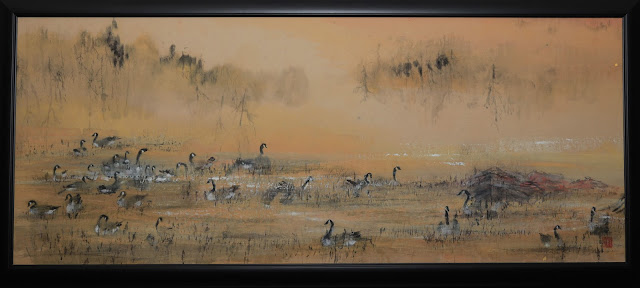I pinned my algae pond painting on the wall and have been digesting it for a couple of weeks.
I know I did the painting out of a notion of trying to capture the algae infested pond in my backyard but I am also keen on playing with my alum solution and the gold speckled Xuan paper.
I know this exercise seems to have nothing to do with traditional Chinese brush but it is so liberating to be able to play and goof off like a rambunctious kid. This painting somehow reminds me of Monet's water lilies pond. Obviously I am not suggesting my painting here is eponymous with the great master's but I suppose I could sniff out a smidgen of that scent.
Whereas I don't have any water lilies in my pond, I do have ducks, frogs and heron. I contemplated adding a heron to my painting but for some reason I think it might be trite. Forget about the marquee actors. Let me give some unknown performers a chance.
How about bees and butterflies and dragonflies. When I think of painting insects, one painter comes readily to mind. Chi Baishi is known for offering a platform for insignificant subjects like fish, cicada, shrimp, crab, mouse, dragonfly, moth etc. His paintings on such topics are simple and honest and ground breaking. Everybody else was painting the lotus flowers and peony.
I see dragonflies darting around my pond. There are a few varieties of them, but the most prominent ones are the red ones and ones with a white body and black markings on their wings. The black and white scheme make these dragonflies very noticeable and should stand out against my blue green background of my painting too. I presume. I shall paint them, they are my unknown performers.
I am posing this dragonfly with its body tilted upwards, revealing its underbelly. I am going to situate this dragonfly resting on top of a twig sticking out of the water. The straight up composition guides the viewer to or away from the painting. It works both ways.
This dragonfly sits farther down the twig, showing its entire white body with wings spread. This is the black and white effect I am looking for.
A dragonfly that is flying away reveals only the white abdomen. Its wings crossed like a propeller due to the lighting conditions. This dragonfly is made to be not entirely succinct to hint motion and also add depth to the perspective. It is my hope that this dragonfly assumes a role of a supporting cast in the background. It gives its presence without robbing the lime lights of the main characters.
I've painted in little blobs of algae that break off from the main patches. I use yellow highlights and dark shadows to give them a three dimensional feel. I treat them as if they are the fresh oregano leaves one sprinkles onto a dish when the food is presented. They are there to decorate and to add flavor.
This shows the composition of the 3 dragonflies. The blobs of algae have not received their yellow highlights and shadows yet and look flat on the paper.
I'm adding a fourth dragonfly to my painting. This one is flying away from the others; its white body radiant in the sun and its wings just a blur. I am giving this dragonfly the strongest white value despite the fact that it is apparently not the main character. It is used to add motion; suggesting the insect is zipping around the pond and direct the viewer to imagine beyond the edges of the painting. This is to contrast with the upward pointing dragonfly at the top of the painting. I've also added a few specks of nondescript bright white objects around this particular dragonfly as a tease. They could be anything, any floating debris. I am using them like decoys to help guide the viewers to this particular dragonfly. You may say that they are like the guiding elements on a UHF antenna. I am hoping that the convergence and divergence of points of interest will help to add intrigue to my painting.
I am trying to avoid parallel lines, which is common in painting water, by painting an undulating, swirling pattern with the help of algae. I am hoping to avoid being stoic and create a sense of liveliness out of this dead body of water.
C'est la vie, it is up to us to find beauty and inspiration in something that is dull and mundane. Whether the situation is an eyesore or poetic topic for a painting, it is our call.




































